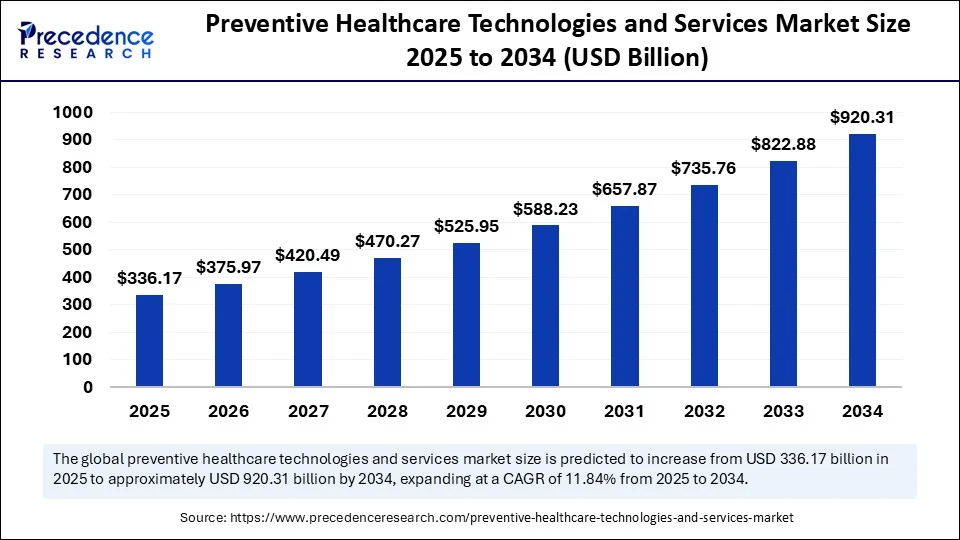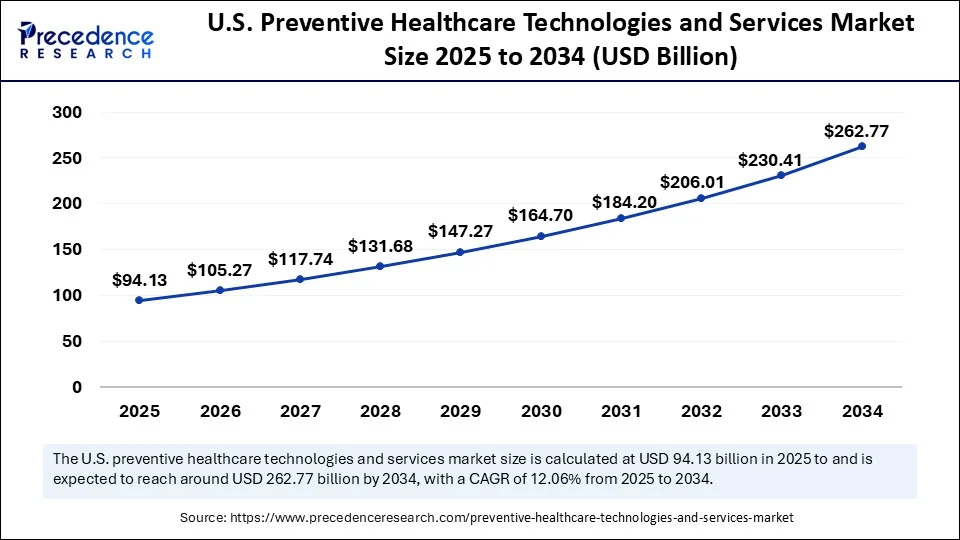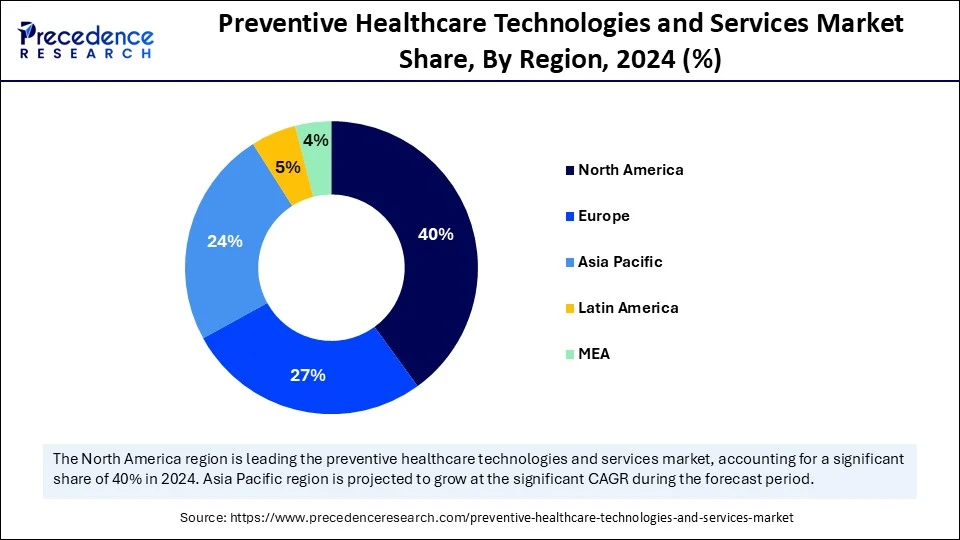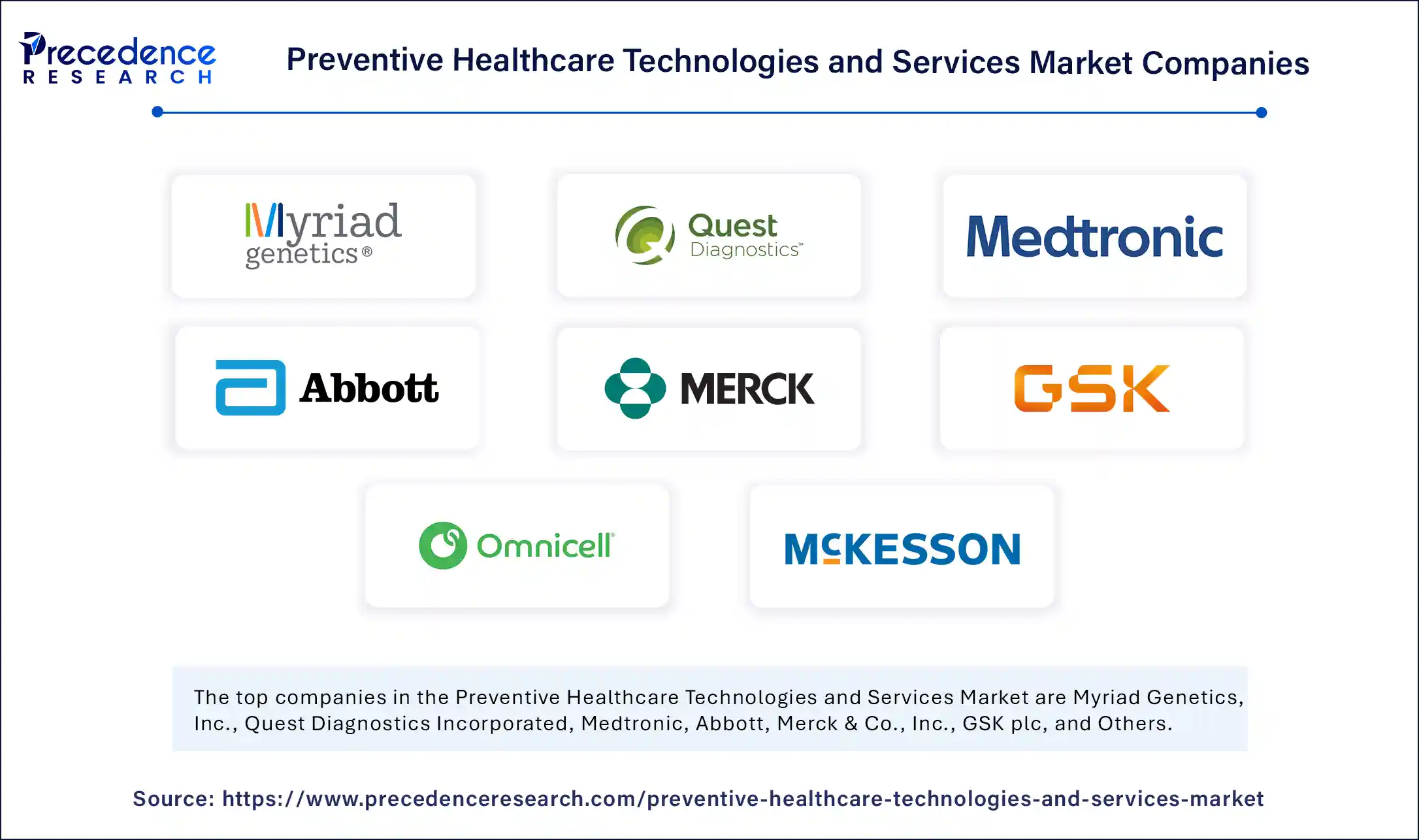List of Contents
Preventive Healthcare Technologies and Services Market Size and Forecast 2025 to 2034
The global preventive healthcare technologies and services market size accounted for USD 300.58 billion in 2024 and is predicted to increase from USD 336.17 billion in 2025 to approximately USD 920.31 billion by 2034, expanding at a CAGR of 11.84% from 2025 to 2034.The market is witnessing substantial growth because of the advancements in screening tools, digital health platforms, and telemedicine solutions to address the growing need for early disease detection and prevention.

Preventive Healthcare Technologies and Services MarketKey Takeaways
- The global preventive healthcare technologies and services market was valued at USD 300.58 billion in 2024.
- It is projected to reach USD 920.31 billion by 2034.
- The market is expected to grow at a CAGR of 11.84% from 2025 to 2034.
- North America dominated the global preventive healthcare technologies and services market with the largest share of 40% in 2024.
- Asia Pacific is expected to grow at the fastest CAGR from 2025 to 2034.
- By type, the vaccines segment held a major market share in 2024.
- By type, the early detection and screening segment is projected to grow at the highest CAGR between 2025 and 2034.
- By end-user, the hospitals segment contributed the biggest market share in 2024.
- By end-user, the clinics segment is expected to expand at a significant CAGR during the forecast period.
How Does AI Impact the Preventive Healthcare Technologies and Services Market?
Artificial intelligence (AI) is transforming the market by facilitating early disease detection, personalized risk assessments, and proactive interventions. AI-powered tools analyze extensive data to identify patterns and predict potential health issues, allowing for timely and targeted preventative measures. Additionally, by scrutinizing patient data, AI aids in developing customized treatment plans that are effective and tailored to individual needs, maximizing treatment efficacy and minimizing adverse reactions. Integrating AI algorithms, particularly in diagnostic and imaging tools, such as X-rays, MRIs, and CT scans, can detect subtle anomalies indicative of diseases like cancer at early stages, surpassing human capabilities.
U.S. Preventive Healthcare Technologies and Services Market Size and Growth 2025 to 2034
The U.S. preventive healthcare technologies and services market size was exhibited at USD 84.16 billion in 2024 and is projected to be worth around USD 262.77 billion by 2034, growing at a CAGR of 12.06% from 2025 to 2034.

How Does North America Dominate the Preventive Healthcare Technologies and Services Market in 2024?
North America dominated the market by capturing the largest share in 2024. This is mainly due to its strong infrastructure, including hospitals, clinics, and research centers, which facilitate the implementation and adoption of preventive healthcare technologies. Additionally, the high adoption of advanced healthcare technologies, increased prevalence of chronic diseases, and supportive government initiatives foster the development of more effective and personalized preventive care solutions. Furthermore, the region benefits from the early adoption of digital health solutions and robust healthcare spending, which supports the development and deployment of preventive healthcare technologies and services.
U.S. Preventive Healthcare Technologies and Services Market Trends
The U.S. plays a major role in the market within North America. The country's leadership is reinforced by its well-established healthcare infrastructure, high adoption of advanced technologies, and a growing awareness of the importance of preventive care. Government initiatives and policies encourage the adoption of preventive healthcare services, enhancing wider access and acceptance. The U.S. government's focus on digital health initiatives and the Affordable Care Act, which emphasizes preventive care, contribute to the market's expansion.
In July 2024, the U.S. Court of Appeals affirmed the Affordable Care Act (ACA) requirement that mandates no-cost preventive health services. The ACA is best known for its achievements in advancing affordable, equitable, and comprehensive health coverage for all Americans; equally important is its prevention-related provisions, including the requirement for insurers to cover selected preventive services at no cost.
(Source: https://www.americanprogress.org)

What Factors Contribute to the Asia Pacific Preventive Healthcare Technologies and Services Market?
Asia Pacific is expected to expand at the fastest CAGR during the forecast period. This is due to the increasing healthcare expenditure in countries like China and India, leading to greater investments in healthcare infrastructure and services, including preventive care. The increasing awareness among people about early detection and prevention of disease and government initiatives promoting preventive care support regional market growth. The adoption of advanced digital health technologies, including telemedicine, is rising swiftly, with governments actively promoting these technologies through various programs to improve healthcare delivery.
In September 2024, a collaboration between Singapore Health Services and the National University of Singapore (NUS) led to the development of SELENA+ (Singapore Eye Lesion Analyzer), which utilizes advanced image processing algorithms to analyze retinal images and accurately and efficiently detect early signs of diabetic retinopathy, glaucoma, and age-related macular degeneration.
(Source: https://itif.org)
China Preventive Healthcare Technologies and Services Market Trends
China plays a significant role in the global market, characterized by rapid growth and investment in this sector. This growth is driven by the country's large population, the increasing prevalence of chronic diseases, and government initiatives aimed at improving healthcare infrastructure and access. Furthermore, advancements in digital health technologies contribute to market growth. There is a rapid shift toward a proactive healthcare approach, contributing to market growth.
India Preventive Healthcare Technologies and Services Market Trends
India is emerging as a major player in the market. This is due to rising health awareness, government initiatives to improve healthcare delivery, and rising adoption of digital health and telemedicine. Government initiatives and policies, like Ayushman Bharat, aim to provide affordable healthcare to a large population, ultimately enhancing preventive care through increased access. Additionally, the National Digital Health Mission supports the adoption of telemedicine and electronic health records, which are pivotal for preventive healthcare.
What Opportunities Exist in the Preventive Healthcare Technologies and Services Market Within Europe?
Europe is expected to grow at a notable rate in the foreseeable future due to its strong emphasis on early disease detection, government investments in preventative care, and rising consumer awareness of health and wellness. Governments and healthcare organizations in the region are making efforts to reduce the burden of chronic diseases and manage healthcare costs. Several initiatives by governments, such as the European Health Union, aimed at bolstering pandemic preparedness and strengthening healthcare systems influence the market. Furthermore, countries like Germany and France are increasingly collaborating on public health initiatives by sharing best practices and leveraging technology to improve health outcomes.
Market Overview
The preventive healthcare technologies and services market focuses on developing and delivering technologies and services aimed at preventing diseases and promoting overall health and well-being rather than treating existing illnesses. It includes a diverse array of interventions, from vaccinations and screenings to wearable devices and personalized health management programs, specifically designed to identify and address potential health issues early, enabling timely interventions before they become serious. The market is experiencing rapid growth, driven by the increasing prevalence of chronic diseases, advancements in digital health technologies, growing awareness of preventive care, and the rising adoption of personalized medicine.
What are the Key Trends in the Preventive Healthcare Technologies and Services Market?
- Increasing Prevalence of Chronic Diseases: The increasing burden of chronic conditions like diabetes, cardiovascular diseases, and cancer is driving a greater demand for preventive measures to manage and mitigate these diseases.
- Advancements in Digital Health Technologies: Continuous innovations in wearable devices, telemedicine, AI, and big data analytics are transforming the landscape and expanding the capabilities and accessibility of preventive healthcare by enabling more effective and personalized interventions.
- Rising Demand for Personalized and Proactive Healthcare: The shift toward personalized medicine and proactive healthcare approaches is spurring the demand for technologies and services that can identify individual risks and tailor interventions accordingly, which is further driving market expansion.
- Rising Awareness and Adoption of Preventive Care: Rising awareness among individuals and healthcare providers about the benefits of preventive measures, such as screenings, vaccinations, and healthy lifestyle choices, can lead to more affordability in the long run by preventing or delaying the onset of chronic diseases, which often require expensive treatments and are fueling market growth.
- Government Initiatives and Support: Governments worldwide are implementing favorable policies and programs to promote preventive healthcare, which include vaccination campaigns, public health awareness campaigns, and support for research and development, contributing to market growth.
Market Scope
| Report Coverage | Details |
| Market Size by 2034 | USD 920.31 Billion |
| Market Size in 2025 | USD 336.17 Billion |
| Market Size in 2024 | USD 300.58 Billion |
| Market Growth Rate from 2025 to 2034 | CAGR of 11.84% |
| Dominating Region | North America |
| Fastest Growing Region | Asia Pacific |
| Base Year | 2024 |
| Forecast Period | 2025 to 2034 |
| Segments Covered | Type, End-User, and Region |
| Regions Covered | North America, Europe, Asia-Pacific, Latin America, and Middle East & Africa |
Market Dynamics
Drivers
Increasing Healthcare Costs and Chronic Diseases Burden
The increasing healthcare cost is a primary driver in the preventive healthcare technologies and services market. Various diseases often require long-term care to manage symptoms and conditions, leading to higher healthcare costs in the long run. This boosts the demand for preventive healthcare, as it is more effective to prevent illnesses than to treat them. The increasing prevalence of chronic diseases, like diabetes, cardiovascular disease, and cancer, which require ongoing management and early detection to mitigate severe health complications, represent a significant global health concern. This leads to a greater demand for proactive healthcare solutions. As healthcare systems shift toward value-based care models, there is an increased emphasis on preventing illness and managing chronic conditions to reduce overall healthcare costs.
Restraint
Higher Initial Costs and Disparities in Access to Advanced Technologies
A major restraint in the preventive healthcare technologies and services market is the higher initial costs and disparities in access to advanced technologies. Disparities in healthcare access arise from the costs associated with developing and deploying healthcare technologies, such as AI-driven diagnostics and wearable health devices, alongside lack of developed infrastructure, especially in rural and underserved areas. Consequently, limited access to technology, lower digital literacy among rural populations, and lack of insurance coverage for digital health services exacerbate health inequalities and slow down overall market growth.
Opportunity
Integration of Advanced Technologies for Personalized and Proactive Care
The rising integration of advanced technologies to provide personalized and proactive care creates immense opportunities in the preventive healthcare technologies and services market. Advanced technologies like AI analyze large volumes of healthcare data, predict health risks, and recommend tailored prevention plans, which make preventive healthcare technologies more efficient. AI can forecast potential health concerns by enabling proactive interventions and preventative measures before conditions worsen, thus identifying unique risk factors and tailoring prevention strategies effectively. Moreover, wearable devices continuously monitor health metrics, providing an opportunity for early detection of health issues.
Type Insights
Why Did the Vaccines Segment Dominate the Preventive Healthcare Technologies and Services Market in 2024?
The vaccines segment dominated the market with the largest revenue share in 2024. This is due to their proven efficacy in disease prevention. Vaccines improve immune system, which defend the body against diseases. With vaccines available for a wide range of diseases, including childhood illnesses, influenza, and emerging infectious diseases, they serve as a versatile solution for public health. Furthermore, ongoing research and development in vaccine technology, such as mRNA vaccines, recombinant DNA technology, and viral vectors, are resulting in more effective and targeted vaccines. The ongoing development of new and improved vaccines ensures the long-term growth of the segment.
The early detection and screening segment is expected to grow at the highest CAGR during the forecast period, driven by its significant impact on improving health outcomes and reducing healthcare costs. Early detection and screening allow for timely intervention and treatment, which leads to better patient outcomes and potentially lower treatment costs. This segment's growth is also attributed to advancements in diagnostic technologies, increased awareness of early disease detection, and the rising prevalence of chronic diseases.
End-User Insights
What Made Hospitals the Dominant Segment in the Preventive Healthcare Technologies and Services Market in 2024?
The hospitals segment dominated the market with a major share in 2024. This is mainly due to the increased emphasis on proactive health management and early disease detection. Hospitals serve a large patient base, boosting the need for preventive healthcare technologies. The increased focus of hospitals in value-based care further bolstered the growth of the segment. This approach allows hospitals to tailor their services and technologies to specific patient demands and preferences, ultimately improving outcomes and increasing patient engagement. By personalizing healthcare plans, hospitals can increase the likelihood of patients adopting recommended preventive measures, promoting better health outcomes and lowering the disease burden.
The clinics segment is expected to grow at the fastest rate in the coming years, primarily driven by the growing emphasis on personalized and proactive healthcare. This approach leverages data analysis to understand patient demands by enabling targeted interventions and preventive measures. As the market shifts from a cross-sectional approach to a more personalized model, clinics increasingly utilize data analytics to gain insight into patient populations, identify at-risk individuals, and develop targeted preventive strategies. This includes analyzing data from electronic health records, wearable devices, and patient surveys to grasp health trends and patterns.
Preventive Healthcare Technologies and Services Market Companies

- Myriad Genetics, Inc.
- Quest Diagnostics Incorporated
- Medtronic
- Abbott
- Merck & Co., Inc.
- GSK plc
- Omnicell
- MCKESSON CORPORATION
Recent Developments
- In April 2025, Tokio Marine Holdings Inc. launched its new subsidiary, Tokio Marine Healthcare Co., Ltd., as part of its broader strategy to provide preventive healthcare services and support workplace health management throughout Japan. This includes services targeting early detection of health risks and lifestyle-related conditions focused on the detection and visualization of health risks based on health checkups and aiding in risk improvement.
(Source: https://www.insurancebusinessmag.com) - In April 2025, Teladoc Health introduced its next-generation Cardiometabolic Health Program to improve population health and prevent the progression of diabetes, hypertension, and obesity. This program supports optimal cardiometabolic health for all populations by promoting healthier behaviors and targeting key measures of cardiometabolic health.
(Source: https://www.stocktitan.net) - In February 2025, Biograph announced its formal public launch and mission to drive significant advances in human healthspan and lifespan. Biograph adopts an evidence-based approach to precision medicine by providing the industry's most personalized care plans for its members. With effective use of advanced medical technology and early detection, the company aims to save many lives.
(Source: https://www.businesswire.com)
Segments Covered in the Report
By Type
- Early Detection and Screening
- Vaccines
- Chronic Diseases Management
- Advanced technologies to Reduce Errors
By End-User
- Hospitals
- Clinics
- Others
By Region
- North America
- Europe
- Asia-Pacific
- Latin America
- Middle East and Africa
For inquiries regarding discounts, bulk purchases, or customization requests, please contact us at sales@precedenceresearch.com
Frequently Asked Questions
Ask For Sample
No cookie-cutter, only authentic analysis – take the 1st step to become a Precedence Research client